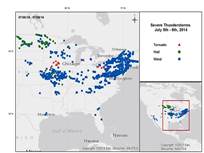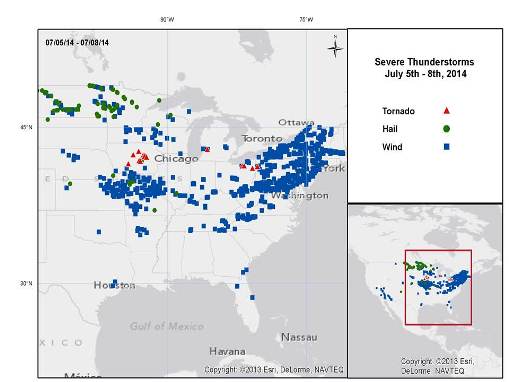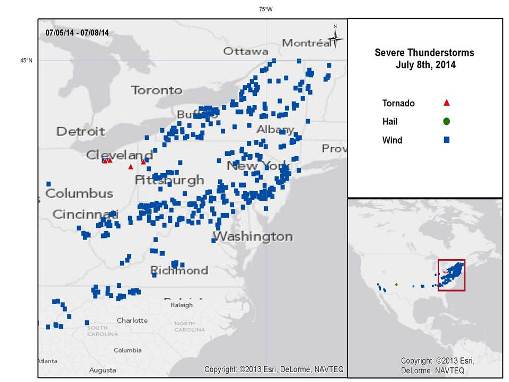

A strong and slow-moving frontal system initiated a series of severe thunderstorm events from July 5-8 affecting an area from the Canadian Prairies to the U.S. East Coast. There have been at least five fatalities.
Most recently on July 8 two swaths of highly clustered straight-line (nontornadic) winds affected the I-90 corridor in New York with another swath affecting the Pennsylvania I-76/I-78 corridors to Long Island, New York. Some confirmed tornadoes have also been reported. The characteristics of the two swaths suggest probable derecho events. Some homes near Syracuse were completely destroyed. Reports of downed trees and power lines are frequent and widespread within these swaths and also include reports of light to moderate property damage. Several hundred thousand were reported without power with highest concentrations on the East Coast overnight last night.

Preliminary severe weather reports from July 5-8. Source: U.S. Storm Prediction Center (NOAA)

Preliminary severe weather reports from July 8. Source: U.S. Storm Prediction Center (NOAA) Hazard data illustrated in the www.i-axs.info for further information.
The system is also responsible for tornado and wind reports in the U.S. Midwest and the Southern Canadian Prairies to as early as July 5.
Meteorological Discussion
The series of severe thunderstorm outbreaks from July 5-8 were initiated in an enabling environment of wind shear from the ground to flight-level (a deep layer of the atmosphere), together with robust moisture and very unstable air with hot deep-summer air at the surface.
Thunderstorms were initiated along and ahead of a powerful and slow-moving frontal system that originated in the Canadian Prairies and slowly sliced through an area including the Great Lakes and Saint Lawrence Valley and southward to include the Midwest, Ohio Valley, and Mid-Atlantic.
Most recently on July 8, reports of damaging straight-line (nontornadic) winds were common according to SPC reports. Two swaths of especially dense wind reports were found south and east of Lakes Erie and Ontario including Syracuse, New York, with another along a line from the West Virginia-Pennsylvania border to Long Island, New York. The wind report clustering suggests probable derecho events affecting these areas. Tornado reports were also found in Medina and Mahoning Counties in Ohio, and Mercer County in Pennsylvania. Damage survey teams were investigating tornadoes near Syracuse, New York. Hail was reported in several locations in Western Pennsylvania, especially in Indiana County. Severe weather warnings were also issued for the Western Canadian Great Lakes and Saint Lawrence Valley.
On July 7 severe thunderstorms affected the Midwest, with damaging straight-line (nontornadic) winds reported in the Central Plains and Mississippi Valley, with concentrated reports affecting Eastern Kansas and Missouri. Hail reports were found in Nebraska (Scott's Bluff County) and parts of Wisconsin (Chippewa County).
On the day prior on July 6, several tornadoes were reported in Iowa, with the highest rating of EF-1 following National Weather Service (NWS) ground surveys (although one of these tornadoes caused impressive ground scouring). Another EF-1 tornado was confirmed by NWS ground surveys in Kent County, Michigan.
Confirmed tornadoes were reported in the Canadian Prairies as early as July 5 from the same weather system. Damaging winds and hail were also reported in the Northern U.S. Plains.
Impacts
Downed trees and power lines with light to moderate structural damage were reported over some very long and wide swaths, especially in New York and Pennsylvania. There were also some reports of houses completely destroyed. While reported individual impacts were generally light, these impacts were densely clustered and over long swaths. While it will take time to determine the full scope of impacts, it is possible that the aggregate of these impacts could be notable.
At least 350,000 experienced power loss as a result of this event.
At least five people were killed, with several injuries reported.
New York
A state of emergency was issued for eastern Syracuse, New York. Smithfield, New York (in the Syracuse area), was one of the most severely affected communities. At least four homes were completely destroyed, and at least four fatalities were reported, including one four-month old. Reports indicated that one home was ripped from its foundation and tossed into another house, but engineering characteristics of the house have to be assessed and reported by ground survey teams. Numerous other homes were also damaged according to reports, together with downed trees and power lines across several New York counties. At least three vehicles were reported buried in debris. Widespread damage was also reported in the towns of Sullivan and Lenox, between Syracuse and Utica, according to emergency management officials. NWS ground survey teams were assessing damage today to determine estimated peak winds and possible tornadoes, and NWS staff has informally estimated winds well in excess of 100 mph. Heavy damage was also reported to a power substation in the Syracuse area. About 44,000 customers were without power as of Wednesday midday according to media reports, down from a peak of at least 72,000 homes and businesses.
Pennsylvania
Reports indicate downed trees and power lines over large areas of Pennsylvania, together with reports of light to moderate structural damage such as roofs torn off houses. Nearly 300,000 lost power at the peak of the storms, with 174,000 people without power in the Philadelphia region. About 135,000 homes and businesses were without power as of Wednesday morning, including 74,000 in the Philadelphia area. One EF-1 tornado was reported in Mercer County in Northwestern Pennsylvania (NWS), with probable tornado reports in Perry, Bradford and Sullivan Counties in Central Pennsylvania.
Maryland
One boy was killed and eight others were injured in Lineboro after trees fell at a camp. Tree and auto damage was also reported in Hagerstown. More than 57,000 were without power as of Wednesday morning. Nearly 34,000 power outages were reported as of early Wednesday afternoon.
Massachusetts
Downed trees and power lines were reported over widespread areas. Some houses were heavily damaged as a result of fallen trees.
Ohio
At least three EF-1 tornadoes were confirmed in Ohio by the NWS. One was confirmed in Hinckley (south of Cleveland), with another in Western Medina County causing minor structural damage to a barn and a few homes. The third affected Canfield Township in Mahoning County, damaging about 10 homes and causing downed trees. No injuries were reported. The NWS is engaged in ground surveys today for other possible tornadoes in the state.
New Jersey
Nearly 23,000 homes and businesses were without power as of Wednesday morning. Downed trees and power lines affected many areas, impacting the morning commute for New Jersey residents. Rail power line repair reduced New Jersey Transit to a single track on the Montclair-Boonton Line.
Vermont
Downed trees, power lines and power outages affected many locations in Vermont as a result of strong winds and heavy rain. Power outages affected 13,300 customers early Wednesday according to reports, and the number has since been reduced to about 3,195.
West Virginia
In Berkley County, strong wind gusts caused mobile homes to flip according to media reports. Several other homes were damaged, together with power outages in Wood County. At least one injury was reported in Cuzzart. Downed trees were also reported in Parkersburg.
Washington D.C. Area
More than 28,000 customers were reported without power in Montgomery County, with at least another 3,600 in Prince George's County. The District of Columbia reported about 200 customers without power as of 8 p.m. EDT.
Michigan
On July 6 an EF-1 tornado was confirmed in Kent County in Byron Center before moving into Wyoming and Kentwood. Impacts were reported by the NWS to be severe but not widespread. Significant home damage was reported in Western Michigan, where estimated winds exceeded 80 mph. At least six people were injured. Downed trees and power lines were also reported, together with partial to complete roof damage to a number of houses. Two homes collapsed according to reports, leading to two hospitalizations. Many roads were impassable as a result of downed trees.
Iowa
Several tornadoes were reported in Iowa on July 6. Two tornado tracks were confirmed, with a rating of EF-1, affecting Tama and Grundy Counties. Damage affected mostly crops. However, several structures were hit west of Reinbeck, where at least two homes were damaged. Other tornadoes were confirmed but not surveyed in Jewell and eastern Jasper County.
North Dakota
Several wind gusts in excess of 84 mph were reported early in the period. Heavy damage was reported at a Missouri River recreation area south of Bismarck. Several injuries were reported. Several tents and vehicles were also destroyed by strong winds and falling trees at Kimball Bottoms on July 5.
Canada
Wind gusts of 82 km/hr (50 mph) were reported in Montréal by Environment Canada. Severe weather warnings were issued in the Southern Ontario and Southern Québec areas. Downed trees and power lines have been reported. Power outages have been reported with most in the Montréal area. Some reports of uprooted trees and light property damage have also been reported by Environment Canada.
Earlier in the period on July 5, the same frontal boundary caused six tornadoes to affect Saskatchewan, Canada including one EF-2 near Outlook, Saskatchewan. The tornadoes damaged barns and a cemetery, but without reports of widespread property damage.
Sources: U.S. National Weather Service (NOAA), U.S. Storm Prediction Center (NOAA), Associated Press, Reuters, Wall Street Journal, The Weather Channel, The Weather Network, Environment Canada.
Guy Carpenter publishes CAT-i reports for major natural catastrophes worldwide. These reports cover catastrophes including worldwide tropical cyclones, earthquakes, major UK and European floods and any other natural event that is likely to incur a significant loss to the (re)insurance industry. Please email CAT.i@guycarp.com if you wish to be added to the free email distribution list
Guy Carpenter compiles RISK-i reports for major technological or man-made events worldwide. These reports cover risks to property, transport and life including explosions, fires, crashes, engineering disasters and terrorist attacks that are likely to incur a significant loss to the (re)insurance industry. Please email RISK.i@guycarp.com if you wish to be added to the free email distribution list.